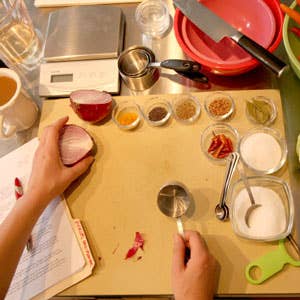
Anatomy Of A Recipe
Cooking is an intuitive and spontaneous process. Recipe testing? Not so much. There's a practiced methodology we follow, and our new kitchen was designed to support it. Here's how it works:
An author sends us a recipe, and the kitchen staff sets out to find the ingredients, always buying more than double the amount the recipe calls for because we almost always test it a second time; that's one reason our test kitchen had to have ample cold and dry storage.
Before we start cooking, we prep the ingredients, measuring them, weighing them, and placing them around us in the order that they're called for in the recipe, along with any equipment required. This demands considerable counter space. The point of this mise-en-place, as the process is called, is to create a calm, organized work area; without this prep stage, we'd be too harried to write down all the visual cues, cooking times, and other telling details that are crucial to refining recipes.
We also have to be diligent about cleaning up after ourselves as we cook, which is why the huge sinks and garbage cans sit within easy reach of the prep table.
When it comes time to taste, the finished dish is set out on the display counter and we take notes on the editors' feedback. We press them for specifics: Are the flavors well balanced? If not, we make a note to adjust the seasonings. Is it crisp enough? No? Maybe on the next attempt we'll try a different browning technique. If the recipe is a flop, that's actually okay; a recipe tester can learn a lot from failures.
Keep Reading
Continue to Next Story










